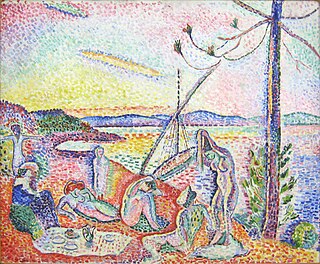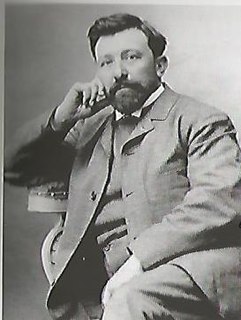


Henri Bouchet-Doumenq (13 May 1834, Paris - 1884) (alternate spellings: Bouchet-Doumeng, Bouchet-Doumencq, Boucher-Doumencq, Boucher-Doumeng, Doumenq-Boucher) was a 19th-century French painter who specialized in portraits and landscapes.



Henri Bouchet-Doumenq (13 May 1834, Paris - 1884) (alternate spellings: Bouchet-Doumeng, Bouchet-Doumencq, Boucher-Doumencq, Boucher-Doumeng, Doumenq-Boucher) was a 19th-century French painter who specialized in portraits and landscapes.
He was the second son of the amateur painter Charles Bouchet-Doumenq, whose family was from Montpellier; a work of Charles hangs at the Fondation Calvet. His mother, Antoinette Bonpard, was a native of Vallant-Saint-Georges. The family home was also shared by a friend of the father, Auguste-Barthélemy Glaize, originally from Montpellier. Doumenq studied painting with Glaize and the Swiss painter Marc-Charles-Gabriel Gleyre of the École des Beaux-Arts in Paris. [1] Doumenq was a friend of the painter Eugène Castelnau, and it is through him he met Frédéric Bazille in 1862. [2] [3] He exhibited his paintings on numerous occasions including La Chanteuse in 1865, Jeune fille faisant un bouquet in 1870, Henri B-D au Salon de 1878 in 1878, La rêveuse (Arles) (n°429) (1880), Jeune mère Arlésienne (n°317) (1883), and Dans le Jardin (1886). His works are present in the collections of several museums, Calvet Museum (Avignon), Museum Petiet (Limoux), Library and Museum Inguimbertine City (Carpentras), and the Museum of Fine Arts (Limoges).
He had at least one sibling, a sister, Caroline. In 1880, at the age of 46, Doumenq married his art student, Magdalene Bernard (1854-1896), with whom he had two children, Pierre-Charles (1887-1890) Jean (1893-1915).

Jean Frédéric Bazille was a French Impressionist painter. Many of Bazille's major works are examples of figure painting in which he placed the subject figure within a landscape painted en plein air.

Alexandre Cabanel was a French painter. He painted historical, classical and religious subjects in the academic style. He was also well known as a portrait painter. According to Diccionario Enciclopedico Salvat, Cabanel is the best representative of the L'art pompier, and was Napoleon III's preferred painter.

Paul Dubois was a French sculptor and painter from Nogent-sur-Seine. His works were mainly sculptures and statues, and he was also a portrait painter.

François-Louis Français (1814–1897), also known as Louis Français, was a French painter, lithographer and illustrator who became one of the most commercially successful landscape painters of the 19th century. A former pupil of Gigoux, he began his career by studying lithography and wood engraving, becoming a prolific illustrator and print-maker. His work as an illustrator is to be found in around forty books and numerous magazines from the late 1830s to the 1860s. Français also produced a large number of pen and ink drawings, enhanced by sepia, notable for their attention to detail and for their technical adroitness and conciseness.

Auguste-Barthélemy Glaize (1807–1893) was a French Romantic painter of history paintings and genre paintings.

Luxe, Calme et Volupté is an oil painting by the French artist Henri Matisse. Both foundational in the oeuvre of Matisse and a pivotal work in the history of art, Luxe, Calme et Volupté is considered the starting point of Fauvism. This painting is a dynamic and vibrant work created early on in his career as a painter. It displays an evolution of the Neo-Impressionist style mixed with a new conceptual meaning based in fantasy and leisure that had not been seen in works before.

Jean Alexis Achard (1807–1884) was a French painter.

Léon-Henri-Marie Frédéric was a Belgian Symbolist painter. His earliest paintings joined Christian mysticism with pantheistic themes, while his later works increasingly reflected social concerns. Much of his work also shows the influence of fifteenth and sixteenth century Flemish art and Renaissance painting styles.

Henri Béraldi was a French bibliophile, publisher and author of books on the Pyrenees and on French printmakers of the 19th century.
Jean-Charles Tardieu, also called "Tardieu-Cochin" was a successful French painter during the ages of Napoleon and of the Bourbon Restoration. His work was primarily historical, but also included landscapes, portraits and religious subjects.

Louis Monziès was a French painter and etcher. He was the curator of the three Museums of Le Mans for 10 years until his death.

Jean-Baptiste-Antoine Guillemet was a French renowned landscape painter and longtime Jury member of the Salon des Artistes Francais. He was one of the first 19th-century artists to paint modern life, and a pivotal figure in the transition from Realism to Impressionism.

Auguste-Xavier Leprince was a French artist and painter who attained celebrity at the age of seventeen. His patrons included the Duchesse de Berry, Charles X, and Alexandre du Sommerard. He was also a teacher; in his twenties he established his own atelier in Paris, with pupils including his two younger brothers, Robert-Léopold and Pierre-Gustave, as well as Eugène Lepoittevin and Nicolas Alexandre Barbier. His meteoric career came to an abrupt end and his "brilliant promise was cut short by his premature death at the age of twenty-seven."

Charles Albert d'Arnoux, known as Bertall or Tortu-Goth was a French illustrator, engraver, caricaturist, and early photographer.

Artists in Isabey's Studio is a painting of 1798 by the French artist Louis-Léopold Boilly, showing many artists who were influential under the French Directory. It was displayed with 529 other works at the 1798 Paris Salon, which was mainly noted for Gérard's Psyche and Cupid. It is now in the Louvre, whose collections it entered in 1911.

Charles-Henri Pourquet, born Henri Charles Justin Pourquet was a French sculptor.

Portrait of Marguerite de Conflans is a c.1876 oval oil on canvas portrait by the French painter Édouard Manet. It is owned by the Musée d’Orsay, though it is on display in the red salon at the Musée des Augustins in Toulouse. Like A Bar at the Folies-Bergère, the work mimics Ingres in its use of a mirror to show the figure from several angles, a motif rarely used by Manet.

Eugène Henri Alexandre Chigot was a post impressionist French painter. A pupil of his father, the military painter Alphonse Chigot, in 1881 he entered the internationally renowned École des Beaux-Arts in Paris where he was exposed to the ideas of the realist movement of the Barbizon School and to Impressionism. He settled in Étaples in the Pas-de-Calais in an artists’ colony, later returning to Paris where he became a founder of the Salon d’Automne. An official military painter he painted a series of canvases in Calais and Nieuport recording the destruction caused by the First World War.

Adolphe-Hippolyte Couveley, originally Couvelet was a French painter and lithographer who specialized in maritime subjects.

Eugène Baudouin was a French painter and printmaker.
![]() Media related to Henri Bouchet-Doumenq at Wikimedia Commons
Media related to Henri Bouchet-Doumenq at Wikimedia Commons